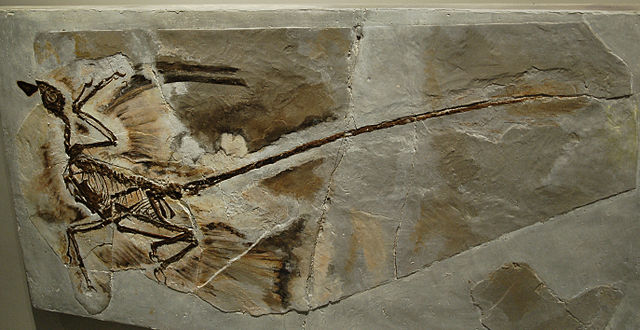genus of fossil reptiles From Wikipedia, the free encyclopedia
Microraptor was a small feathered dinosaur. It was a basal theropod related to Velociraptor and Deinonychus. It had flight feathers, and could glide and possibly fly. About two dozen well-preserved fossil specimens were found in Liaoning, China. They come from the Lower Cretaceous Jiufotang Formation, 125 million years ago.
| Microraptor Temporal range: Lower Cretaceous | |
|---|---|
 | |
| Scientific classification | |
| Kingdom: | |
| Class: | |
| Subclass: | |
| Superorder: | |
| Order: | |
| Suborder: | |
| (unranked): | |
| Family: | |
| Genus: | Microraptor |


Adult specimens are 42–83 centimeters (1.4–2.7 ft) long, so Microraptor was one of the smallest dinosaurs.[1][2]
Microraptor is one of a number of 'dinobirds' found in the same area of China. They were buried in volcanic ash during huge eruptions.
Microraptor was among the first non-avian dinosaurs discovered with the impressions of feathers and wings. Three specimens of M. zhaoianus have been described in detail, in addition to two specimens of M. gui and three specimens of M. sp. described by Xu and colleagues in 2003, from which most feather impressions are known.
Unusual even among early birds and feathered dinosaurs, Microraptor is one of the few known bird precursors to sport long flight feathers on its feet as well as its forearms and hands. This led Xu Xing to describe it as a "four winged dinosaur", and to speculate that it may have glided using all four limbs for lift.[3] Their bodies had a thick covering of feathers. A diamond-shaped fan on the end of the tail gave stability during flight.[4]
Sankar Chatterjee found that, in order for Microraptor to glide or fly, the fore and hind wings must have been on different levels (as on a biplane) and not overlaid (as on a dragonfly). Using this biplane model, he calculated possible methods of gliding, and determined that Microraptor most likely launched itself from a perch, swooped downward in a deep 'U' shaped curve and then lifted again to land on another tree. The feathers not directly employed in the biplane wing, like those on the tibia and the tail, could have been used to control and alter the flight path. The hind wings would also have helped control the gliding flight.
Chatterjee also used computer algorithms to test whether or not Microraptor was capable of true, powered flight, in addition to gliding. The data showed that Microraptor could sustain some level powered flight, so it is possible that the animal flew as well as glided.[2]
Seamless Wikipedia browsing. On steroids.
Every time you click a link to Wikipedia, Wiktionary or Wikiquote in your browser's search results, it will show the modern Wikiwand interface.
Wikiwand extension is a five stars, simple, with minimum permission required to keep your browsing private, safe and transparent.